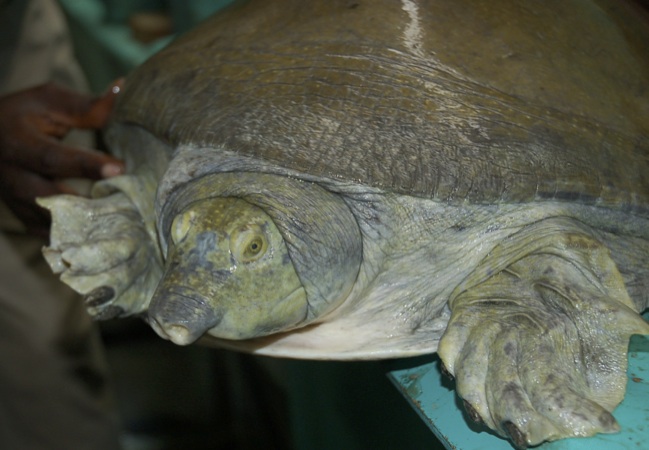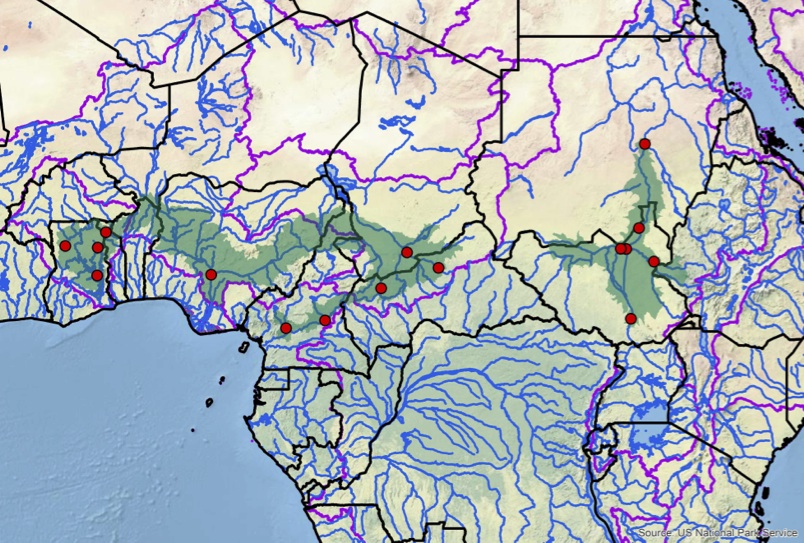Cyclanorbis elegans, 089
Cyclanorbis elegans (Gray 1869) –
Nubian Flapshell Turtle
Patrick J. Baker1, Tomas Diagne2, and Luca Luiselli3,4
1P.O. Box 5689, Addis Ababa, Ethiopia [[email protected]];
2African Chelonian Institute, P.O. Box 449, 33022 Ngaparou/Mbour, Senegal [[email protected]];
3Centre of Environmental Studies Demetra, via Olona 7, 00198 Rome, Italy [[email protected]];
4Niger Delta Ecology and Biodiversity Conservation Unit, Department of Applied and Environmental Biology, Rivers State University of Science and Technology, PMB 5080, Port Harcourt, Rivers State, Nigeria
Summary. – The Nubian Flapshell Turtle, Cyclanorbis elegans (Family Trionychidae), is a large softshell turtle (total carapace length up to 700 mm) from north central Africa. It is the largest and least ossified member of the flapshell subfamily Cyclanorbinae. This highly aquatic species occurs in large rivers of the Sahelo-Sudanese belt from the Mole River in northern Ghana to the Sobat River of South Sudan. The flesh and cartilaginous portions of the shell are known to be consumed in Ghana and South Sudan; however, the species is likely hunted for food throughout its range. In South Sudan, turtle eggs are collected by pastoralists who bring their cattle to feed on the “toic” grasslands that form when the floodwaters of the Nile recede. Records of this species are rare and it is in need of immediate conservation attention.
Distribution. – Benin, Cameroon, Central African Republic, Chad, Ethiopia (probably), Ghana, Nigeria, South Sudan, Sudan, Togo. Large river systems of the Sudanian and Guinea savannah including the Volta River drainage in Ghana and northern Togo, the Niger River, and the White Nile basin of South Sudan and Sudan.
Synonymy. – Baikiea elegans Gray 1869, Cyclanorbis elegans, Cyclanosteus elegans, Tetrathyra baikii Gray 1865 (partim), Cyclanorbis oligotylus Siebenrock 1902.
Subspecies. – No subspecies recognized.
Status. – IUCN 2015 Red List: Near Threatened (NT, assessed 1996), TFTSG Draft Red List: Critically Endangered (CR, assessed 2013); CITES: Not Listed.
Citation:
Baker, P.J., Diagne, T., and Luiselli, L. 2015. Cyclanorbis elegans (Gray 1869) – Nubian Flapshell Turtle. In: Rhodin, A.G.J., Pritchard, P.C.H., van Dijk, P.P., Saumure, R.A., Buhlmann, K.A., Iverson, J.B., and Mittermeier, R.A. (Eds.). Conservation Biology of Freshwater Turtles and Tortoises: A Compilation Project of the IUCN/SSC Tortoise and Freshwater Turtle Specialist Group. Chelonian Research Monographs 5(8):089.1–7, doi:10.3854/crm.5.089.elegans.v1.2015, //iucn-tftsg.org/cbftt/.
(Adobe Acrobat 6.0 or later required)

Adult male Cyclanorbis elegans in captivity.
Photo by Maurice Rodrigues.
Distribution:

Distribution of Cyclanorbis elegans in sub-Saharan Africa. Purple lines = boundaries delimiting major watersheds (level 3 hydrologic unit compartments – HUCs); red dots = museum and literature occurrence records based on Iverson (1992) plus more recent data, and the authors’ personal data; green shading = projected historic native distribution based on GIS-defined level 8 HUCs constructed around verified localities and then adding HUCs that connect known point localities in the same watershed or physiographic region, and similar habitats and elevations as verified HUCs (Buhlmann et al. 2009; TTWG 2014), and adjusted based on authors’ subsequent data.








